Heart of Houston
By Bob Machann
Reprinted from "Crown Jewels of the Wire", May 2005, page 8
Continued from April CJOW
When I got back to my apartment, I got a closer look at the CD 214s. The
damaged ones weren't as bad as they seemed by the pole. One had a burr off one
of her ears. Another had a flat chip on her skirt. The remaining three had
mostly wire groove chips. I kept the one from the crossarm and the one with the
ear damage. The other four I traded for different insulators. The breakage at
the pole was a little disappointing, but I was glad to have removed a CD 214
from a pole for the first time, as well as saving the others for the hobby.
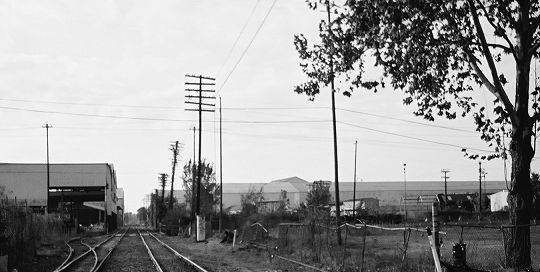
Hobo Heaven
September 28,1996 was a Saturday, and I was walking the tracks again. On this
trip, I wanted to go farther than I had before. Still, I also looked for
insulators at the poles closer to downtown. Along the way, I saw one clear
Hemingray #42 grounder with a badly damaged skirt, which I didn't take with me.
I walked past the warehouses and past the Chaney Junction. Just past Chaney
and the Studemont Street underpass were two houses. Interestingly, one of these
was built facing the railroad tracks. Although the houses were quite old, I wouldn't have minded having a
railroad track on my lawn.
The tracks did not form a straight line between downtown and the Eureka
Junction. At Shepherd Street, the tracks began to curve northward towards Eureka
and onward to Hempstead, in neighboring Waller County. Therefore, it was
especially necessary to monitor the tracks for any oncoming trains.
An unfamiliar locomotive horn sounded as I walked past the alternative
school and towards a large linen and uniform warehouse and the recycling yard. I
looked up to see a bright yellow Union Pacific locomotive coming around the
curve towards downtown. I stepped off the tracks at the Harvard Street crossing,
by the recycling yard.
Moments later, the heavy UP freight thundered past, its flat cars loaded with
oil field pipe. 1996 was the year that Union Pacific trains began showing up on
Houston's SP tracks. There would be many more after this one, and the old SP
/Cotton Belt "bloody nose" locomotives are nowadays bearing the UP
shield and wings.
After the train was gone, I crossed a busy Heights Boulevard and passed the
Heights Antique Barn. After walking over the old wood and steel Yale Street
underpass, I stopped to look at the pole that towered over Yale Street below.
This pole had a sizable number of empty pins. On the Warner television cable
were tangled remnants of the old copper communications wires. At the bottom end
of one of these wires, a blue CD 213 Hemingray hung indolently above Yale
Street.
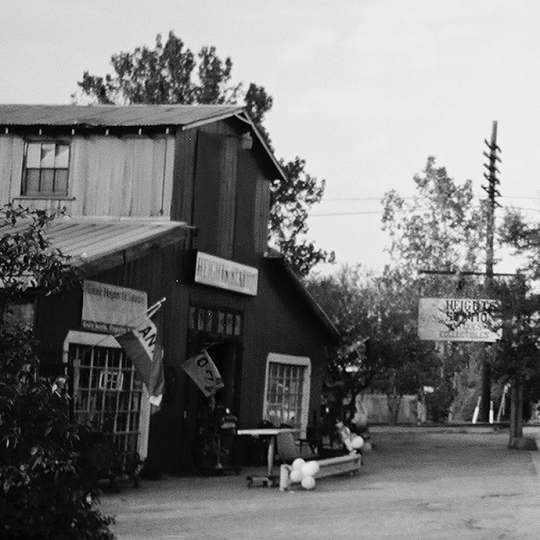
Beyond the underpass, the tracks passed between two plant buildings for
Trinity Industries, a steel fabrication company. Although it was a Saturday, I
could hear metal banging and men yelling inside. There were eight or ten poles
between the Trinity plant and Bonner Street to the west. One of these poles had
doubled arms, and the uppermost set was partially collapsed. At the base of this
pole lay a clear Hemingray #42. This one had a flake on her wire groove, but was
otherwise whole. I was no longer empty-handed.
There were some rather disreputable-looking apartment buildings past the
Trinity plant that didn't seem friendly, so I commenced the return trip. On the walk back, I could see a transient
walking about a half-mile ahead of me. He had a huge orange rucksack on his
back. Some FTRA members are territorial about the tracks they hang out on, so I
kept my distance. It was by the Salvation Army buildings, only a few feet from
the malt liquor bottle shards that I accidentally stumbled onto him. He was
sitting in the grass, leaning back on his rucksack and taking it easy in the
shade of a Salvation Army warehouse. He wasn't rude or threatening. Frankly, he
seemed glad to see me.
For maybe fifteen minutes or so, we chatted with each other mostly about
railroads. The hobo liked the Southern Pacific, but didn't care much for the
Santa Fe or Union Pacific. As we spoke, a Salvation Army truck crept over the
Sawyer Street crossing. The hobo spotted the truck and commented on how welfare
was taking food out of the mouths of hard-working people. Since I was now
working and finding out on my own how hard it was to make ends meet, I was
inclined to believe him.
The b-flat klaxon horn of an oncoming SP train caught our attention. We
decided to get scarce, so we said our good-byes. The hobo went his way while I
disappeared to a dead-end street between two warehouses to railfan the long
container train. Perishable goods were on board, as I could hear the soft
whirring of the reefer units as each intermodal car passed. All in all, I'd had
fun on the tracks that day.
Mysterious Color
There were still insulators to be had from the Chaney
Junction pole. I was driving in the area on President's Day, February 16, 1998,
when I noticed that
two more sets of the doubled Crossarms had been taken down. There was now
only one set remaining on the pole. I parked in the parking lot between a carpet
store that was closed for the holiday and a busy Chevron Station on the corner
of Studemont and Washington. I casually walked up to Center Street, then onto
another street that led up to the tracks. Passing the house facing the tracks
and crossing the underpass structure, I reached the pole and found even more
shattered green aqua CD 214 Hemingray #43s. There was one ice blue Hemingray #42
with a wire groove chip, which I took with me.
As I turned to go, one of the broken insulators in the grass beneath the pole
caught my eye. I reached down to pick her up. She was another #42, and she was
horrendously damaged with wire groove chips and large chunks missing from her
outer skirt. Something about the insulator's color, however, was not quite
right; the insulator seemed greener than usual. Still, I really didn't have time
to do a research project right there by the tracks. The next train was probably
due any minute, and the Houston sky had been threatening rain all day long.
I took the ice blue #42 back to my apartment and immediately cleaned her.
About an hour after I returned home, the weather became really bad. Rain fell,
and I saw the most orange cloud I had ever seen. This very same storm cell
dropped several inches of rain in neighboring Fort Bend County and spawned
tornadoes that damaged the then new First Colony shopping center. The Lone Star
Insulator Club held its February 1998 meeting a few days later. I mentioned what
I had seen to a few of my collecting buddies. While some were mildly surprised,
others were skeptical and felt that a green insulator in downtown Houston was highly
unlikely.
By this time, I was scratching my head over this insulator. The only way to
solve this puzzle was to get that insulator. On the afternoon after the LSIC
meeting, I parked in the same parking lot and went straight to the pole. I
didn't have to look far; the insulator was right where I had left her.
I took the enigmatic insulator back to my apartment and got a closer look.
There were two large half-circle pieces missing from her skirt. This insulator
wasn't just mutilated; she had also been abused. The upper wire groove had three
chips that were almost perfectly spaced apart. It looked as though some
tripod-type device had been clamped onto the insulator's crown. Nevertheless, I
was enthralled with the insulator's color. Her aqua coloration had a distinct
yellow tint, and she did not match any of the aqua #42s in my collection. I kept
the insulator, and I found most of her skirt pieces on later walks of the
tracks. Some of my fellow LSIC members have seen this insulator, and they have
felt that she is in fact green.
Weather the Storm
I was asleep in my apartment on Monday, May 10, 1999. It
was about 6:30 a.m. when I awoke to the sound of a rustling wind outside. Storms
would pass through downtown Houston every so often, so I thought nothing of it
at first. That changed moments later, when the wind began to blow from the
northwest.
The entire west wall of my apartment consisted of windows. There were two
large picture windows on either side of a sliding patio door.
The patio door had a security bolt, which was a thin steel rod inserted into
a small hole drilled into the aluminum doorjamb. Many times, especially on
weekends, I would open the sliding door and stand in the threshold, watching
downtown Houston and the rest of the world go by. I often went out onto the
apartment balcony, although shoes were needed because the balcony was always
coated with a dingy gray inner-city dust.
On this early Monday morning, such a step outside was out of the question.
The wind was now blowing against my apartment building at such an angle that it
made a spooky whistling noise through the hole in the doorjamb. What's more, the
doorjamb began to creak. I could hear glass breaking outside. Whether it was a
window, someone's fragile balcony decoration, or some leftover beer bottles from
the previous Saturday night, the breaking glass was a sign that this wind was
serious.
I got out of a perfectly comfortable bed to monitor the doorjamb. I held onto
it, feeling the shock waves through the aluminum. The wind lasted only a few
moments, but I was on edge about those huge windows. Just as the harsh wind
began to die down, heavy rain began to fall. I went back to bed and got a 15-minute nap before having to wake up again for my alarm clocks.
My broken glass fears were not unfounded. Flying debris shattered a window in
the high-rise's lobby. A few blocks west, windows were broken in the Kellogg
Building. A computer had been sucked out by the winds, and was shown on the
evening news as it lay -- monitor and all -- on the sidewalk many floors below.
A couple of days later, I was driving on Allen Street along the tracks. Just
beyond the intersection where Allen Street forms a T with Roy Street stood a
pole with storm-tossed crossarms. There was a trace of aqua glass at the base of
this pole.
I parked my Oldsmobile at a closed oil field services shop on the other side
of the tracks and quickly hiked over to the pole. A single aqua Hemingray #42
lay beneath it. I picked her up and took her back to my apartment. I had to use
the Woolworth channel locks to remove a broken pin in the pinhole. The wire
groove had some chipping on the Hemingray side, but I added another of the old
Houston insulators to my collection.
Act Fast
May 19, 2001 was an unusually hot spring Saturday in Houston. I took
a break from running errands to examine the crumbling poles near the Trinity
Industries plant. The Yale Street underpass had pedestrian passageways, as did
Houston Avenue. Chain-link fences placed just beside the roadway, however,
precluded access to the railroad embankment. Some creative walking was required.
I parked my Olds in a Bank of America parking lot and crossed Washington
Avenue on the corner. I then cut across Center Street and past the Heights
Antique Barn before reaching the tracks. Once on the tracks, I had to sidestep
the carcass of a track-kill opossum that was buzzing with flies. As I crossed
over Yale Street, there was a gaping hole in the underpass' wooden platform
(which has since been repaired). A car zoomed by underneath as I stared into the
hole. It was a mild shock for me, but I also felt sorry for any tramp that had
to walk over that platform in the dark.
Once again, I walked between the two Trinity Industries plant buildings. The
Saturday crew was there, as usual. A few spans west of Yale, at the base of a
pole lay a tramp bracket with four CD 214 Hemingray #43s. Unfortunately, all
four were clear and had large cracks in the domes, as well as other chips. I
already had an insulator like these in my collection, and these weren't in the
best condition. I reluctantly left them behind and went on about my business.
The very next weekend was the Memorial Day weekend. I took a short walk on
the tracks, passing through the Trinity complex. As I walked past the poles, the
tramp bracket was gone. There were no shards on the tracks, so I knew they
weren't broken. My guess is that another collector got them, or perhaps a
Trinity employee helped himself to the insulators. Oh, well.
Spurs with Signals that Jingle, Jangle, Jingle
June 27, 2002 was a Thursday.
I was coming home from work that evening, driving westbound down Washington
Avenue. As I approached Studemont Street, I noticed that the crossing signals on
the Sacks spur were lighting up. At first, I thought they were malfunctioning. I
had driven this street for eight years, and not once had I seen a train on the
Sacks spur. Still, the cantilever crossing sticks came down obediently. Moments
later, a klaxon horn sounded, and a Union Pacific switch engine crept over the
crossing. The engine continued down the spur towards the Sacks Waste Paper
building, passing the new Walgreen's pharmacy on the corner. This was the only
time I had seen traffic on that spur.
At one time, the spur crossed Buffalo Bayou and served a Houston Lighting
& Power maintenance center on the other side. Two steel trestle structures,
both of which had faded Southern Pacific logos painted on them, had overarched
Memorial Drive and Allen Parkway. These structures and the trestle were removed
in the autumn of 1999.
Better to Have Wigwagged & Lost...
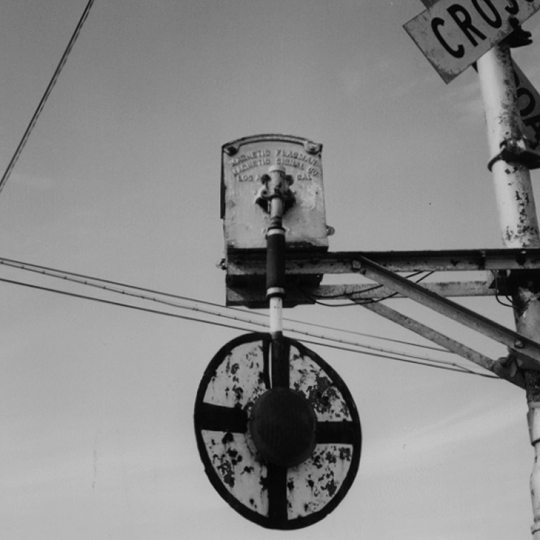
Along Washington Avenue was a railroad antique that I had not seen in a long
time. At the end of National Street, before the entrance of a cabinet factory,
stood a genuine wigwag signal. At one time, these signals were very common on
the Santa Fe. Since this particular one was on a UP track, I suspected that it
could possibly be Santa Fe salvage. I was indeed fortunate to have seen the
wigwag's performance. On a morning in May 2002, I was gassing up my Chevy truck
at the Texaco bodega on Washington Avenue, the same one from which I had bought
the bagged Coke six years earlier.
A long freight had just finished passing over Chaney Junction from the north
track, headed westward. Bare seconds later, a locomotive horn sounded nearby,
and I glanced up National Street in time to see the wigwag signal come to life.
I was too far away to hear the bell, but the light came on and the banjo swung
back and forth dutifully as the locomotive of a second westbound freight crept
over the crossing. This was the first time I had seen that wigwag in action.
On September 4, 2002 in the evening, I was dumping some paper at a recycling
bin along Washington Avenue. As I did, a UP train of empty auto-loaders passed
by. I got back into my truck and headed for National Street. Sure enough, when I
arrived, the banjo was lit and swinging. This time, I could hear the bell
ringing, so I now had proof positive that the wigwag was fully functional.
This would turn out to be the only time I saw the wigwag in complete
exhibition. A few weeks later, I passed by the National Street crossing only to
find a brand-new cantilever signal set at that location. Progress strikes again.
Laid Low?
Since the terrorist attack on America on September 11, 2001,
railroad police have been more vigilant of unwanted persons on or near railroad
tracks, regardless of whether they are terrorists or transients or local
residents. I still keep a close eye on the poles, all the while trying to remain
on public property as much as possible.
On February 1, 2003, the day of the space shuttle Columbia disaster, I did
sneak a very short walk behind the junkyard. I had gone there because almost all
of one pole's five crossarms were broken in two and hanging by their support rods.
I walked up the Sacks spur, past the bakery's truck yard, to the main line.
It was hoped that one of the insulators from the broken crossarms had fallen,
but there were no grounders beneath either of the two poles behind the junkyard.
I couldn't tell if any insulators had fallen into the junkyard due to the
eight-foot-high security fence surrounding it.
I hadn't been there two minutes when a long UP freight thundered over Chaney
Junction from the north track to the main line. This train was great for
railfanning, never mind that I was hanging out on railroad land. Anyhow, no one
gave me any flak for trespassing, and I quickly left the area once the train had
passed.
I no longer live in the downtown Houston area, but I do pass through my oId
neighborhood now and then. I still get a kick out of seeing these tough old
poles still standing in the heart of the city, despite their mostly common
insulators. As for the dark CD 152 that I spotted near Oliver Street, that
insulator is still atop her pole nearly a decade after I first saw her.
Railfanning is easy here, too. I have come back to the Harvard Street recycling
yard to watch trains go by as well as drop off my recyclable garbage. The tracks
are a railroad carnival, 24 hours a day, seven days a week.
Mr. N.R. Woodward and I have discussed this line many times, and I would
like
to thank him for the historical information he has provided.
Also, many thanks to Matthew Dittert and Dan Furtado of
the "Texas
Wigwags" page on www.trainweb.org
for their assistance with the wigwag
photos.
Needless to say, the search goes on.
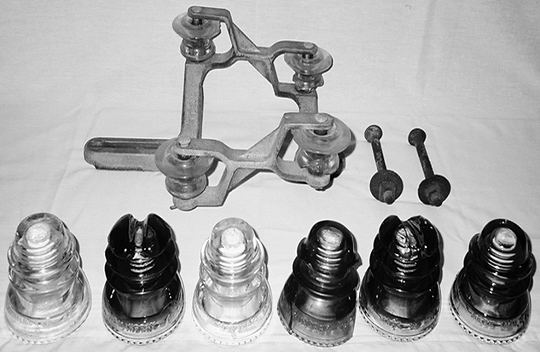
Insulators in my collection from this line.
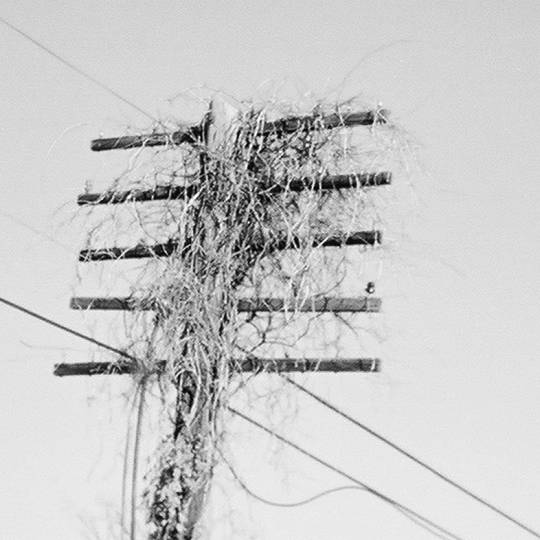
This pole is on Allen Street. It has the only porcelain insulator that I have
seen on the line
| 